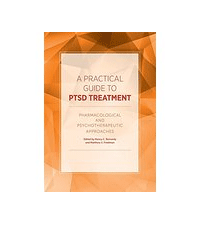“A Practical Guide to PTSD Treatment: Pharmacological and Psychotherapeutic Approaches.”

“A Practical Guide to PTSD Treatment: Pharmacological and Psychotherapeutic Approaches.”
Edited By Nancy C. Bernardy & Matthew J. Friedman
American Psychological Association
Washington, D.C., 2015
Book provides ‘limited’ look at treatment approaches
Reviewed by Kerry Morrison, Psy.D
Posttraumatic Stress Disorder affects seven million Americans. It is largely conceived as a disorder of reactivity that results in an inability to cope with overwhelming stress.
PTSD has a distinctive pattern of symptoms. There are four specific phenotypes of the disorder; anxiety, depression, externalizing and dissociative. This edited volume seeks to translate scientific research on PTSD into testable clinical approaches that are evidence-based and can be utilized to develop comprehensive treatment plans for clients.
The book is geared towards mental health professionals. It aims to provide a psychobiological context to understanding the human stress response and to integrate psychopharmacology with psychotherapeutic approaches.
The book is well organized and addresses many current topics in the treatment of PTSD. Theoretical concepts such as resilience and common co morbid disorders such as insomnia and substance abuse will likely be of special interest to many practitioners.
The chapters on medication: antidepressants, anxiolytics, atypical antipsychotics and anticonvulsants were helpful; especially the sections on SSRIs and SNBRIs, but at times were overly detailed and might not hold the interest of those who are not overly familiar with pharmacology.
The description of the categories of medication, the names of specific medications commonly prescribed and the area of the brain they target were up to date and relevant. However, an area of concern was the lack of mention of the epidemic problem with addiction to benzodiazepine treatments.
In my opinion, caution was not given strongly enough to limit or avoid use of these medications in the treatment of PTSD or other disorders.
The sections on psychotherapy largely focused on CBT treatment as research has found these approaches be the most effective in the treatment of PTSD. I found this material to be narrowly focused and did not offer much detail in terms of the types of approaches within CBT and other therapeutic models.
The lack of description and discussion of different treatment approaches might be disappointing to many therapists who often do not adhere to one singular technique, but a combination.
The authors noted that trauma-focused therapies are the first line treatments for PTSD, but the articles didn’t adequately describe them or compare and contrast.
And that lack of discussion of a range of effective approaches, pharmacologically and psychotherapeutically, I think, was the book’s downfall.
Some interesting statistics were given about the use of medication, where 30 percent of subjects achieve full remission and 50 percent improve clinically, but therapy, specifically CBT, was found to be more effective than medications.
Maybe this is a result of the lack of breadth in the current research, but what about more comprehensively studying the combined effects of different types of therapy and medications in the treatment of PTSD?
The authors briefly mention the need for more research on the interaction effect of therapy and medications, but namely in the context of CBT and the length of time on medication, withdrawal syndromes and efficacy.
Overall, this volume offers some interesting information, but was limited in the review of a variety of psychotherapeutic treatment approaches combined with the interaction effect of medication on the complex disorder of PTSD. n
Kerry Morrison, Psy.D. is a licensed psychologist in private practice in Greenfield, MA.
Learn more about the book: A Practical Guide to PTSD Treatment: Pharmacological and Psychotherapeutic Approaches
